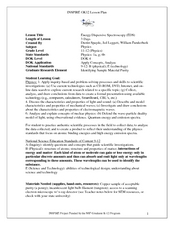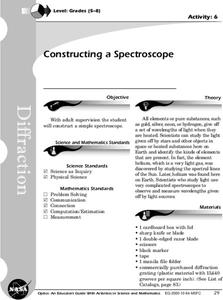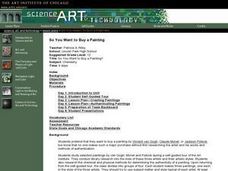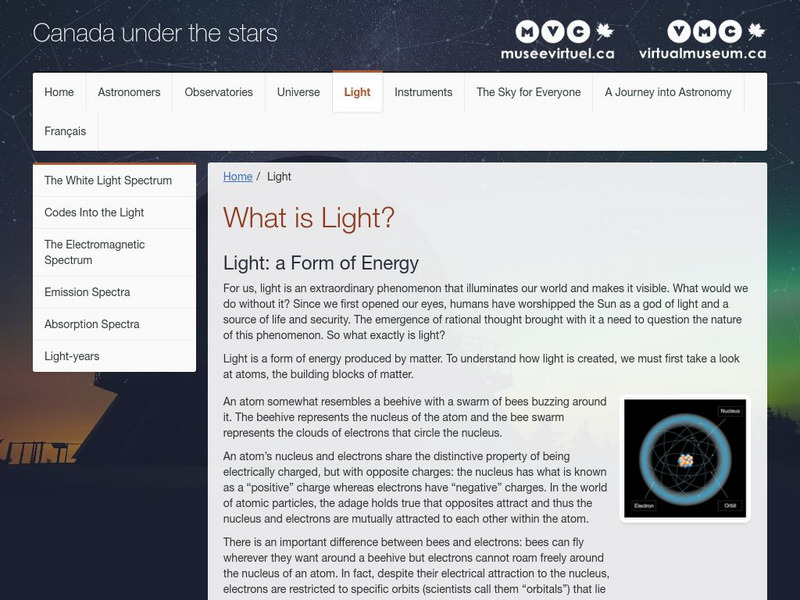Mr. E. Science
Stars, Galaxies and the Universe
It takes 225 million years for our sun to travel around the galaxy. The presentation covers astronomical units, light years, telescopes, types of stars, the life cycle of a star, and types of galaxies. This is the last lesson in a...
Curated OER
The Electromagnetic Radiation (Light ~ the Supreme Informant!)
This short slide show applies the electromagnetic spectrum to astronomy. First, electromagnetic radiation is introduced to viewers. Wavelength is defined and its unit of measurement explained. Finally, aspiring astronomers find that the...
Curated OER
Spectroscope
Young scholars examine how to apply conservation of energy and properties of matter to a spectroscope. In this energy lesson plan students build their own spectroscope and observe three kinds of spectra.
Curated OER
The Grating Spectrometer; Light and Wavelengths
Students create a paper model that demonstrates wave interference for 3 wavelength from 2 sources. In this light and wave lesson, students use a real spectrometer and observe and measure the wavelength of spectral lines. Students then,...
Curated OER
Spectral Classification of Stars
In this spectral composition of stars worksheet, students use data collected by a spectroscope to compare the stellar spectra to a standard for 5 stars. Students compare the spectral lines to the temperatures of the stars.
Curated OER
The Modern Atom
In this modern atom worksheet, students answer 7 questions about electron configurations of atoms, flame tests, spectroscopy, the energy of electrons and quantum numbers. Students write electron configurations and orbital filling diagrams.
Curated OER
Spectroscopy Homework
In this spectroscopy worksheet, students answer 4 questions about spectrometers, spectroscopy, flame tests and the energy of given wavelengths of light.
Curated OER
Discovery 4-1 Atomic Emission Spectra
In this emission spectra worksheet, students use a spectroscope to observe three types of spectra. These include continuous spectrum, emission spectrum and absorption spectrum.
Curated OER
Flambe Elements
Eighth graders discuss atoms and electrons as well as atoic structure. They view atomic structure via the computer. Students watch a demonstration in which the teacher demonstrates glass tubing turning yellow in a Bunsen Burner flame....
Curated OER
Using the Spectrometer
In this physics learning exercise, students observe white light through a spectroscope and describe what they see. Then they observe fluorescent light with the spectroscope and describe what they see. Students also describe why it is...
Curated OER
Examining Spectra
High schoolers examine the spectra with the use of light while constructing their own spectroscope. They make observations about the colors and visible wavelengths of light and then conduct classroom discussions. As an extension students...
Curated OER
Generate a Calibration Curve for Chlorophyll a
High schoolers measure and graph the absorbance of light by chlorophyll at a specific wavelength versus chlorophyll concentration. They are given an unknown and determine its concentration from their calibration curve. Students become...
Curated OER
Energy Dispersive Spectroscopy
Students calculate the values of electron binding energies. In this physics instructional activity, students solve for different wavelength characteristics of X-rays. They present their findings to the class.
Curated OER
Overhead Spectroscopy
High schoolers explore the relevance and importance of data collection and analysis techniques that use different parts of the electromagnetic spectrum. They observe the basic concepts of the visible electromagnetic spectrum and the...
Curated OER
Ways to See the Sun
Pupils examine how the regions of the Sun are studied using spectroscopy. They investigate the electromagnetic spectrum and the types of radiation that are associated with it. They use prisms and CD's to examine the light spectrum. They...
Curated OER
Constructing a Spectroscope
Students construct a simple spectroscope. They observe the emission spectrum produce by a source of light.
Curated OER
Simple Spectroscope
Students make a spectroscope out of simple materials and are expected to view as many different light sources as possible to see the whole spectrum.
Curated OER
Analytical Spectroscope
Students using a spectroscope view different substances when heated with electricity.
Curated OER
So You Want to Buy a Painting
Twelfth graders research physical and chemical methods used in authenticating paintings (e.g., ultraviolet fluorescence and spectroscopy, infrared spectroscopy and reflectography, X-ray diffraction, microscopy, pigment analysis, and gas...
Carnegie Mellon University
Chem Collective: Dna Binding Dyes Scenario
This activity explores the equilibrium of dyes that self-assemble into DNA templates. Students use knowledge of equilibrium and quantitative spectroscopy to explore different dyes that bind selectively to DNA molecules. In this activity,...
University of Alberta
The University of Alberta: Infrared Spectroscopy
Complete this interactive tutorial and learn about interpreting the infrared spectrum ("I" "R") that provides information about the functional groups in a molecule. Included are 12 labs and a quiz.
University of Colorado
University of Colorado: Physics 2000: Spectral Lines
Several pages from an excellent site which describe the science of spectroscopy. The unique atomic emission (and absorption) line spectrum of elements are illustrated and explained. Includes a Java applet depicting the quantum energy...
Science Buddies
Science Buddies: How Blue Is Your Sports Drink?
Do you read the list of ingredients in foods and drinks before you buy them at the grocery store? If you do, you may have noticed that many of the items that are blue in color have the same dye, called FD&C blue 1. In this chemistry...
Other
Vmc: What Is Light?
What is light? A detailed examination of what creates light, light spectrums, scientists' discoveries, and colored graphics. Appropriate for the older student or adult researcher.

























